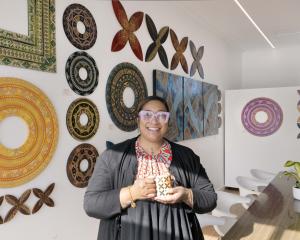This week in Art Seen, James Dignan looks at exhibitions at Milford Gallery, Blue Oyster Art Project Space, and The Artist's Room.
 Two Figures by Jeffrey Harris.
''Show and Tell'', John Parker, Mark Mitchell, Jeffrey Harris, Andy Leleisi'uao, Leanne Morrison and Reuben Paterson (Milford Gallery)
Two Figures by Jeffrey Harris.
''Show and Tell'', John Parker, Mark Mitchell, Jeffrey Harris, Andy Leleisi'uao, Leanne Morrison and Reuben Paterson (Milford Gallery)

The Milford Gallery's annual ''Show and Tell'' exhibition gives an overview of some of the country's best artists. This year's display is no exception.
Six artists have work highlighted: ceramicists John Parker and Mark Mitchell, painters Jeffrey Harris, Andy Leleisi'uao and Leanne Morrison and glitter maestro Reuben Paterson. The latter's contribution to the exhibition are a departure from the artist's usual themes, but still a continuation of his exploration of Pacificana.
Parker and Mitchell present groups of works which, although widely different in appearance, use the interplay of shape and form. Parker's delicate chesspiece-like bottles in calm autere white include new flanged and grooved features, which build on his earlier work. Mitchell's bowls glow with their coloured gridlike patterns and softly crackled interiors.
Leleisi'uao's paintings continue to create their own mysterious ancient wall-frieze influenced narratives. Jeffrey Harris' work, though with its own mysterious narratives is produced in compellingly bold, confident strokes.
The new artist in the group, Leanne Morrison, presents strong yet subtle abstracts in which blocks and stripes of seemingly solid colour reveal soft, captivating nuances of shade. This gives the works a surprising appearance of three-dimensionality and depth.
 ''New Gold Mountain'', Mark Schroder (Blue Oyster Art Project Space)
''New Gold Mountain'', Mark Schroder (Blue Oyster Art Project Space)

When Chinese prospectors travelled to California to seek their fortunes in the goldfields, they referred to America as ''The Gold Land''. The same prospectors, travelling to Victoria and Otago, christened these later goldfields as ''The New Gold Land'' - a land of promise where luck became a driving force for obtaining or earning a fortune.
Mark Schroder examines the lucky history of the settlement of Dunedin, built on the back of Central Otago gold and on the commercial finance it brought into the region. We are presented with a seeming jumble of advertising, huxtering, and red tape, presenting the manner in which the city played on and created its own luck.
In doing so, we are also presented with the hollow underbelly that comes with this gamble: Dunedin as a south sea bubble, open to exploitation and to the whim of fortune.
The multilayered labyrinth of this exhibition allows viewers to read their own interpretation into the array of materials presented. The whole gallery has been taken over, including the usual office space and bank vault (a legacy from a former occupant of the building).
Whether Schroder is successful in his attempt to depict the cycle of boom and bust, of honest business and shysterism, is left up to the individual to decide.
 She Won’t Forgive You, by Tyler Kennedy Stent
''You Shouldn't Be Sleeping'', Tyler Kennedy Stent (The Artist's Room)
She Won’t Forgive You, by Tyler Kennedy Stent
''You Shouldn't Be Sleeping'', Tyler Kennedy Stent (The Artist's Room)

Tyler Kennedy Stent's exhibition at The Artist's Room builds on his exhibition at the same gallery early last year.
Both exhibitions use as their raw material images that were indelibly marked on the artist's brain during his time in Nepal in the aftermath of the country's devastating earthquake in 2015.
Stent's great artistic gift is his ability to portray emotion in his subjects. His group portraits, more often than not featuring young children, capture his sitters' inner feelings, and present them within a strong narrative-rich context. The often slightly ambiguous titles (which in this exhibition form their own story) add further to the narrative mix.
The works rely on juxtaposition of wildly opposed colours to build up their emotional tension. Amazingly, much of the paintwork is done with watercolour over a textured gesso base, despite the normal association of watercolour with soft tones.
A powerful use of negative space is also found in many of the works, with areas of canvas left blank or unprimed. This allows the emptiness to become an almost oppressive presence. In some works, the characters are left incomplete; in A Family Portrait After the Earthquake the central mother figure is barely present, so drained by the events which surround her and from which she must protect her family.












